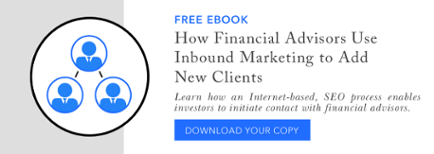6 Reasons Why Financial Advisors are Slow to Adopt Inbound Marketing
It is well-established that the financial services industry (financial advisors in particular) is slow to adapt to technological changes. Industry leaders and experts have been sounding the alarm for years: Adapt or get left behind. That is certainly true as it relates to the rapid advance of advice automation, which is leading to the commoditization of advice and fee compression. However, on a more fundamental level, and much more threatening to their immediate survival, is the failure of financial advisors to embrace new marketing technologies.
Clients are Leading the Change in the Digital Age
The digital age is changing everything, including the way consumers want to be marketed to and contacted. Although consumers have never been a fan of the traditional outbound marketing tactics used by financial advisors, such as cold calls and direct mail, in years past, it was one of the only ways they would come in contact with an advisor if they needed one.
Today, the Internet enables consumers to determine who they will talk to, when and how. And, if any contact with an advisor is made, it is the consumer who initiates it. That is bad news for advisors who still cling to traditional outbound marketing methods. But, it is great news for advisors who learn to embrace the digital age and the new marketing opportunities it creates – specifically inbound marketing.
What is Inbound Marketing?
Inbound marketing is an Internet-based process of attracting prospects to your website and encouraging them to initiate contact with you through the use of relevant content. By pushing out high-quality, focused content that resonates with your ideal target market, you create the opportunity to develop digital relationships that can lead to prospects contacting you when they are ready to learn more about you.
An effective inbound marketing strategy relies on four key elements:
- A quality, SEO-optimized website designed to attract visitors with the capability of converting traffic into leads
- Quality content that increases your visibility as an authority on the Internet
- A CRM system to convert leads into qualified prospects
- A system to convert prospects into clients
Once all of the pieces of the inbound marketing strategy are in place, it can become a cost-effective and self-sustaining source of leads. Studies show that inbound marketing delivers 54 percent more qualified leads than traditional outbound marketing. Why is it, then, that 86 percent of financial advisors continue to cling to outdated, expensive and ineffective marketing methods?
Why Advisors Don’t Use Inbound Marketing
While it is true that financial advisors tend to be slow adopters of any technology, inbound marketing has been around for awhile and it has proven its effectiveness among the 14 percent of advisors who have adopted it. Even compliance departments, once the go-to excuse for advisors not to try new marketing methods, are starting to come around, with many clearing a path for advisors to use inbound marketing. So, what’s holding financial advisors back from the opportunity to find more qualified prospects?
1. “It’s Complicated”
The concept of inbound marketing is fairly simple – using digital tools to attract, cultivate and convert qualified leads into clients. However, to get the apparatus up and running to where it’s generating a constant stream of quality leads can be quite involved. There are several moving parts, each requiring its own specialized expertise to operate, which must function in unison to produce the best results.
Most advisors don’t have the time, knowledge or inclination to take on such an intricate marketing strategy and many don’t know where to turn to find digital marketing experts with intimate knowledge of their business.
2. “It’s Too Expensive”
It’s possible to build a basic website and install an off-the-shelf CRM system for next to nothing. You can even create content at no cost except for your time. However, you are not likely to achieve the results you need, so any cost is probably going to yield a poor return on investment.
Developing a high quality, lead-generating website is not inexpensive, but the return on investment can be extremely high. A CRM system customized for your offering and target market is not cheap but, if it is wired right, it will keep your pipeline full of quality leads and prospects. What is that worth to you? If you don’t have the time or skill to produce quality content, you have to pay a writer and, with content, you get what you pay for. However, quality content that targets your ideal prospects is the primary driver of an inbound marketing strategy – the better your content, the better your return.
When compared to the continuing costs of hiring a telemarketer, printing and delivering mailers or putting on several seminars, all of which rely on the law of large numbers and none of which produce meaningful, sustainable results, an inbound marketing strategy is much more cost effective.
3. “It Takes Too Long to See Results”
There’s no disputing that inbound marketing is a marathon and not a sprint. It takes time to get all of the wheels in motion to where it generates meaningful results. However, in the same way advisors guide their clients to exercise patience and discipline in their long-term investment strategy, advisors need to understand that it takes time for inbound marketing efforts to reach a point of critical mass when it can generate sustainable results. But, when that happens, the cost per lead continues to decline and ROI increases over time.
4. “I Don’t Have a Website”
If you don’t have a website, you can’t do inbound marketing properly. But that should be the least of your concerns. At a minimum, a website is today’s business card, without which your legitimacy can come into question. Recognizing this, many financial advisors or their firms rushed to create simple, static websites, which sufficed as digital brochures but were largely unimaginative and technologically lacking.
For the more discerning, tech-savvy clients, these templated websites don’t instill a high level of confidence. Without the proper SEO structure and technology, it is very unlikely to show up in any Google search results. You might as well be invisible to your market.
Eighty-three percent of financial advisors have a website, but only a small percentage have discovered the value of a high-quality, content-rich website in creating a true online presence. By adding a blog and linking to their social media sites, they increase their visibility while establishing themselves as a trusted authority. They are just a few steps away from monetizing their website with a complete inbound marketing strategy.
5. “We Already Use Marketing Automation”
Marketing automation has been around since the 1990s and has proven effective at cultivating existing prospects via email campaigns and converting them into clients. However, it is not the same as inbound marketing, which focuses on attracting visitors to your website and then converting them into leads. You can have a great marketing automation program but, if you aren’t generating new leads, your marketing automation database will dry up. If you aren’t using inbound marketing to add to your database, you are using outbound marketing methods, such as telemarketing, direct mail, networking and seminars, which are more time-consuming, expensive and less reliable for generating quality leads.
An effective inbound marketing strategy incorporates key elements of marketing automation for the purpose of cultivating leads, but it adds the critical component of delivering the right content to the right people at the right time, which encourages them to take action.
6. “I Don’t Know Who to Turn to for Help”
The good news is there are hundreds of inbound marketing agencies ready to help you. The bad news is that most of these agencies don’t have the specialized industry knowledge required to design and execute an inbound marketing strategy for financial advisors. You need a team of professionals who understand investors and the market niches you want to penetrate. There are also compliance and regulatory issues to contend with and you don’t want to be paying someone to learn on the job.
The right agency will have a track record of helping financial advisors and firms execute successful inbound marketing strategies.
Some financial advisors may have valid reasons for not adopting inbound marketing, such as compliance restrictions or a lack of a marketing budget. However, many of their reasons are based on misconceptions, misinformation or a miscalculation of the cost-effectiveness of an inbound marketing strategy over more expensive and less effective traditional outbound marketing methods. When it comes to generating leads, many financial advisors are more comfortable sticking with what they know, which is not a reason; it’s just avoiding the inevitable.


